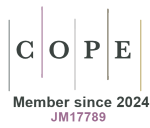Submissions
Submission Preparation Checklist
As part of the submission process, authors are required to check off their submission's compliance with all of the following items, and submissions may be returned to authors that do not adhere to these guidelines.-
The corresponding author, on behalf of all co-authors certifies that:
a) All listed authors meet authorship criteria, have approved the manuscript and are in agreement to its submission.
b) This submission is original: it has not been previously published, nor has it been submitted to another journal for consideration in a similar form, in any language or country, except as an abstract or preliminary report; if any part of it is not owned by the authors, appropriate permission for its reproduction has been obtained and is attached to this submission.
c) Financial support and conflict of interest statementsfor all authors have been appropriately acknowledged in the "Acknowledgements" section of the manuscript file.
Please note:
Manuscripts reporting the results of experimental investigation on human subjects must include full details of acceptance by the appropriate institutional committee or review board and a statement that the study was performed according to the Declaration of Helsinki has been included.
This submission platform is integrated with ORCID. All authors will be invited to connect their ORCID profile to this article. Find out more about ORCID and its integration here.
By submitting your contribution you agree to its screening using iThenticate by CrossCheck.
Editorial (on invitation only)
Editorials are on invitation only. The purpose of the editorials is to provide the reader with a balanced overview of relevant and up to date topics, often reflecting the opinion of the Journal. No abstract is required.
Words: max 3000 (excluding figures and tables) | Figures/Tables: max 4 | References: 30
Review
Reviews are intended to focus on the current state of knowledge or practice, integrating recent advances with accepted principles and practice, or summarizing and analyzing consensus view of controversial issues in knowledge of practice. A non-structured abstract is required.
Words: max 5000 (excluding figures and tables) | Figures/Tables: max 8 | References: no limit
Point of View
Points of view are intended to present viewpoints on the interpretation of recent investigations in any research area. Points of view are fully referenced, peer reviewed articles and must offer a clear presentation of the authors’ perspective and a constructive discussion. A non-structured abstract is required.
Words: max 3000 (excluding figures/tables) | Figures/Tables: 4 | References: max 30
Original Research Articles
Previously unpublished manuscripts, describing clinical, pre-clinical, epidemiological investigations, clinical trials, clinical observations, and other relevant investigations that are based on sound patient series, validated analytical methods, and appropriate statistical evaluation. Systematic reviews and meta-analysis can also be submitted as Original Research Articles. Original Research Articles should be structured as follows: Introduction (clearly stating an objective or hypothesis), Methods (describing the study design and methods applied, including the study setting and dates, patients or participants with inclusion and exclusion criteria, and/or participation or response rates, or data sources, and how these were selected for the study), Results (describing the results of the study in context with the published literature and addressing study limitations), and Conclusions (addressing relevant implications for clinical practice or health policy). A structured abstract (250 words) is required.
Words: max 3000 (excluding figures and tables) | Figures/Tables: max 6 | References: max 50
Short Communication
This article type reports of results from original researches. They must provide conclusive findings: preliminary observations or incomplete findings cannot be considered for publication. A structured abstract is required
Words: max 2000 (excluding figures and tables) | Figures/Tables: max 3 | References: max 7
Correspondence
Letters to the Editor and letters in reply are intended to present opinions or comments on articles published in the Journal. Letters are subject to abridgement and editing for style and content. A letter in reply must cite the title of the letter, e.g., “Response to (Title of Letter)”. An abstract is not required.
Words: max 500 (excluding figures and tables) | Figures/Tables: max 1 | References: max 5
Congress report
A congress report covers scientific, medical, health policy or other healthcare related topics presented at an important scientific meeting that will be of interest to readers.
Copyright Notice
Authors contributing to Global & Regional Health Technology Assessment agree to publish their articles under the CC-BY-NC 4.0 license, which allows third parties to re-use the work without permission as long as the work is properly referenced and the use is non-commercial.
Privacy Statement
Personal information entered in this journal site will be used exclusively for the purposes of Global & Regional Health Technology Assessment (GRHTA) and will not be made available for any other purpose or to any other party. The data collected from registered and non-registered users of this journal falls within the scope of the standard functioning of peer-reviewed journals and are detailed in the Privacy Policy. It includes information that makes communication possible for the editorial process; it is used to inform readers about the authorship and editing of content; it enables collecting aggregated data on readership behaviors, as well as tracking geopolitical and social elements of scholarly communication, in compliance with the European Union’s General Data Protection Regulation (GDPR)
For any questions, concern or comment you may have about this journal’s privacy policy or any requests concerning your personal data, please contact us.






